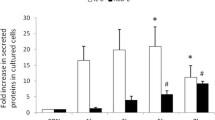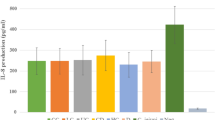Abstract
The effect of intestinal molecules produced by the host on the virulence of Pseudomonas fluorescens is poorly documented. In the present work, we evaluated the secretion of human β-defensin-2 (hBD-2) by enterocytes after infection with P. fluorescens (a species previously suggested to be involved in inflammatory bowel disease) and investigated the effect of this host-defense peptide on the bacterial virulence. The results showed that P. fluorescens can induce hBD-2 production in Caco-2/TC7 cells via P38 and ERK MAPK-dependent pathways. Surprisingly, the exposure of P. fluorescens to low doses of the antimicrobial peptide was found to enhance its cytotoxic and proinflammatory effects suggesting a potential feedback mechanism in the dialog between bacteria and the host.





Similar content being viewed by others
References
Bardoel BW, van der Ent S, Pel MJ, Tommassen J, Pieterse CM, van Kessel KP, van Strijp JA (2011) Pseudomonas evades immune recognition of flagellin in both mammals and plants. PLoS Pathog 7:e1002206
Blier AS, Veron W, Bazire A, Gerault E, Taupin L, Vieillard J, Rehel K, Dufour A, Le Derf F, Orange N, Hulen C, Feuilloley MG, Lesouhaitier O (2011) C-type natriuretic peptide modulates quorum sensing molecule and toxin production in Pseudomonas aeruginosa. Microbiology 157:1929–1944
Burini JF, Gugi B, Merieau A, Guespin-Michel JF (1994) Lipase and acidic phosphatase from the psychrotrophic bacterium Pseudomonas fluorescens: two enzymes whose synthesis is regulated by the growth temperature. FEMS Microbiol Lett 122:13–18
Chamaillard M, Dessein R (2011) Defensins couple dysbiosis to primary immunodeficiency in Crohn’s disease. World J Gastroenterol 17:567–571
Chapalain A, Rossignol G, Lesouhaitier O, Merieau A, Gruffaz C, Guerillon J, Meyer JM, Orange N, Feuilloley MG (2008) Comparative study of 7 fluorescent pseudomonad clinical isolates. Can J Microbiol 54:19–27
Dalwadi H, Wei B, Kronenberg M, Sutton CL, Braun J (2001) The Crohn’s disease-associated bacterial protein I2 is a novel enteric t cell superantigen. Immunity 15:149–158
Donnarumma G, Buommino E, Fusco A, Paoletti I, Auricchio L, Tufano MA (2010) Effect of temperature on the shift of Pseudomonas fluorescens from an environmental microorganism to a potential human pathogen. Int J Immunopathol Pharmacol 23:227–234
Dössel J, Meyer-Hoffert U, Schröder JM, Gerstel U (2012) Pseudomonas aeruginosa-derived rhamnolipids subvert the host innate immune response through manipulation of the human beta-defensin-2 expression. Cell Microbiol 14:1364–1375
Ganz T (2005) Defensins and other antimicrobial peptides: a historical perspective and an update. Comb Chem High Throughput Screen 8:209–217
Hancock RE, Scott MG (2000) The role of antimicrobial peptides in animal defenses. Proc Natl Acad Sci USA 97:8856–8861
Huang LC, Redfern RL, Narayanan S, Reins RY, McDermott AM (2007) In vitro activity of human beta-defensin 2 against Pseudomonas aeruginosa in the presence of tear fluid. Antimicrob Agents Chemother 51:3853–3860
Jackson MK, Phillips SN (1996) Necrotizing hepatitis in pet birds associated with Pseudomonas fluorescens. Avian Dis 40:473–476
Jung MY, Kim HS, Hong HJ, Youn BS, Kim TS (2012) Adiponectin induces dendritic cell activation via PLCgamma/JNK/NF-kappaB pathways, leading to Th1 and Th17 polarization. J Immunol 188:2592–2601
Klockgether J, Munder A, Neugebauer J, Davenport CF, Stanke F, Larbig KD, Heeb S, Schöck U, Pohl TM, Wiehlmann L, Tümmler B (2010) Genome diversity of Pseudomonas aeruginosa PAO1 laboratory strains. J Bacteriol 192(4):1113–1121
Madi A, Lakhdari O, Blottière HM, Guyard-Nicodème M, Le Roux K, Groboillot A, Svinareff P, Doré J, Orange N, Feuilloley MG, Connil N (2010a) The clinical Pseudomonas fluorescens MFN1032 strain exerts a cytotoxic effect on epithelial intestinal cells and induces Interleukin-8 via the AP-1 signaling pathway. BMC Microbiol 10:215
Madi A, Svinareff P, Orange N, Feuilloley MG, Connil N (2010b) Pseudomonas fluorescens alters epithelial permeability and translocates across Caco-2/TC7 intestinal cells. Gut Pathog 2:16
Nuding S, Zabel LT, Enders C, Porter E, Fellermann K, Wehkamp J, Mueller HA, Stange EF (2009) Antibacterial activity of human defensins on anaerobic intestinal bacterial species: a major role of HBD-3. Microbes Infect 11:384–393
Okuda J, Hayashi N, Okamoto M, Sawada S, Minagawa S, Yano Y, Gotoh N (2010) Translocation of Pseudomonas aeruginosa from the intestinal tract is mediated by the binding of ExoS to an Na, K-ATPase regulator, FXYD3. Infect Immun 78:4511–4522
Picot L, Mezghani-Abdelmoula S, Chevalier S, Merieau A, Lesouhaitier O, Guerillon J, Cazin L, Orange N, Feuilloley MG (2004) Regulation of the cytotoxic effects of Pseudomonas fluorescens by growth temperature. Res Microbiol 155:39–46
Ramasundara M, Leach ST, Lemberg DA, Day AS (2009) Defensins and inflammation: the role of defensins in inflammatory bowel disease. J Gastroenterol Hepatol 24:202–208
Schneider JJ, Unholzer A, Schaller M, Schafer-Korting M, Korting HC (2005) Human defensins. J Mol Med (Berl) 83:587–595
Selsted ME, Ouellette AJ (2005) Mammalian defensins in the antimicrobial immune response. Nat Immunol 6:551–557
Sperandio D, Rossignol G, Guerillon J, Connil N, Orange N, Feuilloley MG, Merieau A (2010) Cell-associated hemolysis activity in the clinical strain of Pseudomonas fluorescens MFN1032. BMC Microbiol 10:124
Veldhuizen EJ, Rijnders M, Claassen EA, van Dijk A, Haagsman HP (2008) Porcine beta-defensin 2 displays broad antimicrobial activity against pathogenic intestinal bacteria. Mol Immunol 45:386–394
Veron W, Orange N, Feuilloley MG, Lesouhaitier O (2008) Natriuretic peptides modify Pseudomonas fluorescens cytotoxicity by regulating cyclic nucleotides and modifying LPS structure. BMC Microbiol 8:114
Wehkamp J, Harder J, Wehkamp K, Wehkamp-von Meissner B, Schlee M, Enders C, Sonnenborn U, Nuding S, Bengmark S, Fellermann K, Schröder JM, Stange EF (2004) NF-kappaB- and AP-1-mediated induction of human beta defensin-2 in intestinal epithelial cells by Escherichia coli Nissle 1917: a novel effect of a probiotic bacterium. Infect Immun 72:5750–5758
Wehkamp J, Fellermann K, Stange EF (2005) Human defensins in Crohn’s disease. Chem Immunol Allergy 86:42–54
Wehkamp K, Schwichtenberg L, Schroder JM, Harder J (2006) Pseudomonas aeruginosa- and IL-1beta-mediated induction of human beta-defensin-2 in keratinocytes is controlled by NF-kappaB and AP-1. J Invest Dermatol 126:121–127
Yoon YM, Lee JY, Yoo D, Sim YS, Kim YJ, Oh YK, Kang JS, Kim S, Kim JS, Kim JM (2010) Bacteroides fragilis enterotoxin induces human beta-defensin-2 expression in intestinal epithelial cells via a mitogen-activated protein kinase/I kappaB kinase/NF-kappaB-dependent pathway. Infect Immun 78:2024–2033
Acknowledgments
This study was supported by grants from the Conseil Général de l’Eure, the Communauté d’Agglomération d’Evreux and Europe. LMSM is a member and supported by the world’s leading center Cosmetic Valley.
Author information
Authors and Affiliations
Corresponding author
Additional information
Communicated by Djamel Drider.
Rights and permissions
About this article
Cite this article
Madi, A., Alnabhani, Z., Leneveu, C. et al. Pseudomonas fluorescens can induce and divert the human β-defensin-2 secretion in intestinal epithelial cells to enhance its virulence. Arch Microbiol 195, 189–195 (2013). https://doi.org/10.1007/s00203-012-0865-3
Received:
Revised:
Accepted:
Published:
Issue Date:
DOI: https://doi.org/10.1007/s00203-012-0865-3




